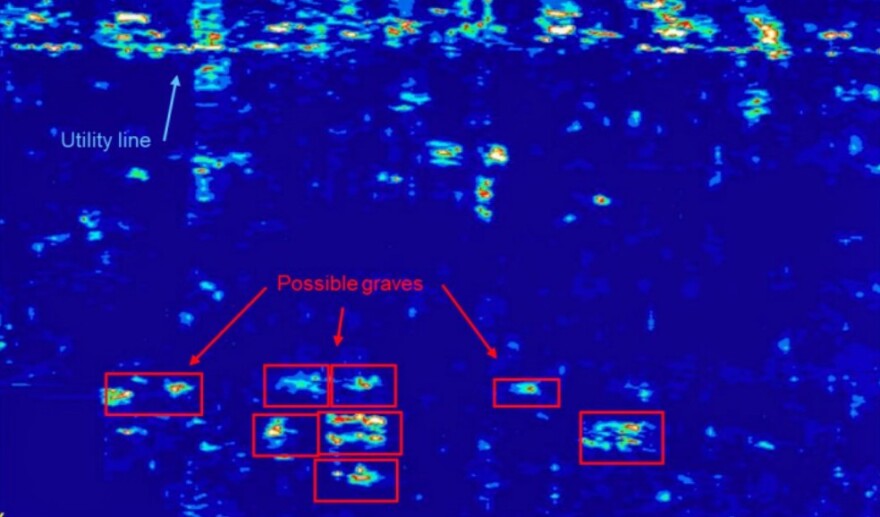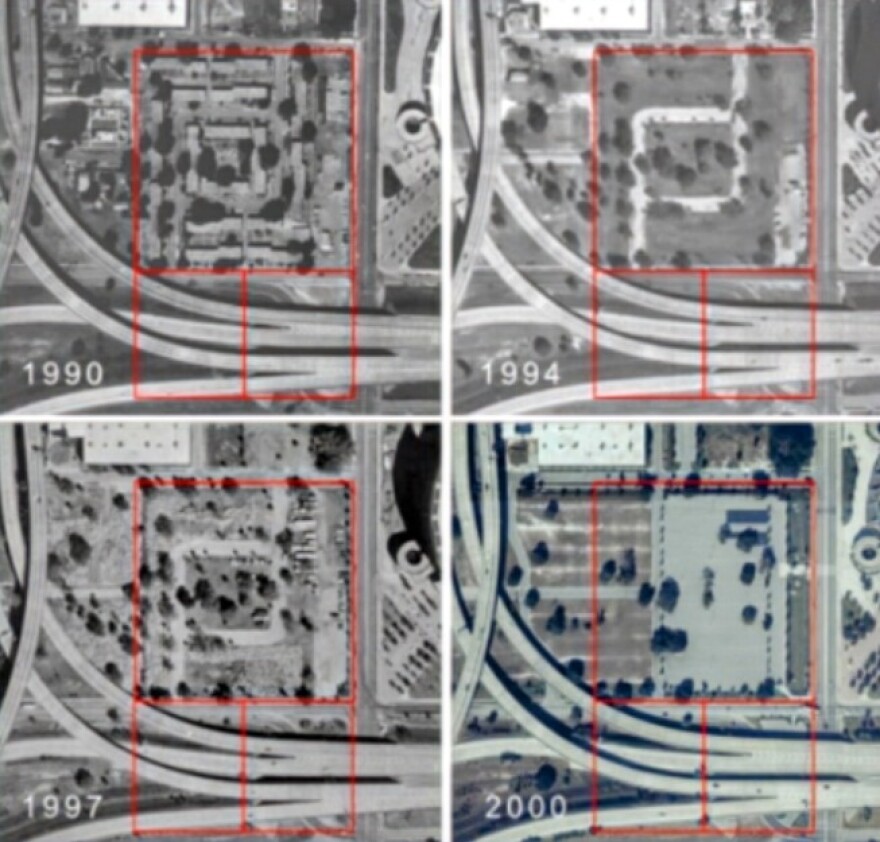Ground penetrating radar has uncovered 10 possible graves – some just three feet below ground – underneath Tropicana Field’s parking lots.
The new study, reviewed by the Catalyst, also found 11 areas of interest and nine unidentified disturbances. Verifying results requires exhuming remains.
Engineering and environmental consulting firm Stantec delivered its long-awaited 83-page report to St. Petersburg’s mayoral administration in November 2024. The findings have remained hidden from the public, including the descendants of the interred, amid evolving plans to redevelop the area for a fourth time.
“Stantec recommends that no ground-truthing or other archaeological work be conducted without first consulting with potential descendants and stakeholder groups connected to Oaklawn Cemetery,” states the report. “The goal of any such work would be to confirm the presence of intact burials and gain a better understanding of the potential for disturbed human remains within the property – and of the distribution of burials and human remains across the property.”
City Councilmember Corey Givens Jr. believes official conversations and community outreach regarding the latest findings are overdue. Ground penetrating radar (GPR) first identified three possible graves beneath Lots 1 and 2 at the Trop in August 2021.
In May 2024, the city enlisted Stantec to conduct an expanded GRP survey at the former Oaklawn Cemetery. The studies are personal for Givens.
“I have a great-great-grandfather who may or may not still be buried underneath the parking lots at Tropicana Field,” Givens said. “So, I want to give him and the other people who may or may not be buried underneath that parking lot a dignified final resting place.
“These are people who were disrespected in life, and now we’re disrespecting them in death.”

Stantec also conducted extensive historical research complicated by inconsistent death and burial records. Those issues were more prevalent among people of color and poor residents.
Oaklawn Cemetery, platted in 1907, sits west of 16th Street and between 3rd and 5th Avenues South. It predominantly served the White population.
Evergreen Cemetery, established in 1900, served Black residents and now sits under I-175. Both races were interred at Moffett (St. Petersburg) Cemetery, established in 1888 at the intersection of 16th Street and 5th Avenue South.
The city condemned the contiguous burial grounds in 1926 and relocated bodies according to race. African Americans were moved to the much-maligned Lincoln Cemetery in Gulfport. Their Caucasian counterparts stayed closer to home, at Royal Palm Cemetery.
“I don’t want what the city council did in 1926 to happen again – where it was out of sight, out of mind,” Givens said. “They said, ‘Bulldoze and build over it. And if there are bodies underneath the parking lot, oh well, just keep building.’”
In 1949, the construction of the Royal Court Apartments uncovered the first bodies. That became the Laurel Park housing complex in 1966, which unearthed additional remains and artifacts.
In 1976, construction workers building I-275 found a human skull and various bones. Redevelopment continued.
Laurel Park made way for Tropicana Field in 1990. Now, 35 years later, widespread suspicions that the site still contained human remains have proved true.

“I wasn’t shocked, I was sad,” Givens said. “But what I did not expect to find was that we’d be able to put names to some of those folks who were buried out there at Oaklawn.”
White residents accounted for at least 100 of the 113 graves confirmed at Oaklawn. Stantec noted that 5th Avenue South, Interstate I-175 and the Historic Gas Plant District redevelopment plans impeded access to adjacent burial grounds.
The mayoral administration and Tampa Bay Rays were engaged in a tense standoff regarding the site’s future when Stantec completed the report in November 2024. A new stadium would have anchored the once predominantly Black neighborhood’s rebirth.
Rays owner Stuart Sternberg walked away from previously signed agreements in March. A site potentially riddled with human remains may not look as attractive to prospective buyers.

The issue extends far beyond Lots 1 and 2. “When 5th Ave South was constructed through the three cemeteries in the 1920s, it undoubtedly impacted at least some burials,” states the report.
“Stantec recommends that after ground-truthing work is conducted at Oaklawn Cemetery, additional GPR work should be done within the roadway along 5th Avenue South … to determine if any potential burials exist there,” it continues. “If future roadway improvements or utility work is done within this area … a professional archaeologist should be on hand to monitor for the presence of human remains.”
Stantec and Givens stressed that descendants and stakeholders should determine the city’s next steps. “I also don’t think we should be keeping this private,” Givens said.
He called not honoring those forgotten under a sea of asphalt a “slap in the face.” Givens criticized his colleagues in City Hall for not prioritizing memorial efforts.
Research can now provide the names of reinterred Black bodies and closure to descendants. Many families did not receive burial information, nor were they welcomed in then-rural Gulfport.
“These people didn’t live amongst each other, and they weren’t buried amongst each other,” Givens said. “We separated them even in death.”
Givens, intent on providing a dignified final resting place, will broach the subject at a May 1 city council meeting. He believes officials should follow the lead of other local governments and at least erect a historical marker.
“We can help draw a picture so people have a better understanding of their history,” Givens added. “If we don’t acknowledge our history, it’s bound to repeat itself.”
This content provided in partnership with StPeteCatalyst.com



